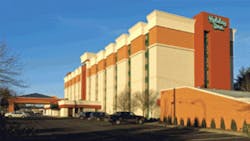New Cooling-Coil Dehumidifier Helps Clean Up ‘Mess’ of Hotel Pool Area
When The Chambers Group Inc., a Seattle-based management company, took over operation of the Howard Johnson Hotel, now a Holiday Inn, in downtown Everett, Wash., in late 2004, the swimming-pool area was, in the words of Doug Bartells, general manager of the hotel and a principal of The Chambers Group, “a mess.”
“The pool room had suffered 20-some years of deterioration from chlorine and moisture,” Bartells said. “Everything was affected … the paint on the walls, the sheetrock itself was waterlogged, the wall studs were affected, plus anything metal had rusted or corroded. We essentially had no functioning air-handling system, and the pool water was a ghastly brownish color.”
As part of a 14-month, $13 million renovation of the hotel, the new management team called in GB Systems of Kenmore, Wash., to design, engineer, and install a new air-handling system for the pool room.
“We were looking for energy efficiency and, clearly, an air-handling system that would avoid the moisture problems that plagued the previous owner,” Bartells said.
PREVIOUS SYSTEM
“The old system was a 100-percent exhaust with a gas-fired makeup-air system,” Greg Berg, principal of GB Systems, said. “The system was an original installation and reflected the way things were done in the early 1980s, when the emphasis was on air changes, with the expectation that outside air would flush out the humidity. It appeared that the temperature—both the pool water and in the space—had not been very stable.”
Berg continued: “Swimming pools have become more sophisticated—they are their own ecosystems. With all the chlorine injection and interest in glass windows, you need more-frequent air exchange. Also, the pool temperature needs to be lower than the air temperature. When that doesn’t happen, moisture problems are inevitable. You don’t want the pool heating the room space.”
SOLUTION
“With Greg’s help, we selected a cooling-coil dehumidification system to wring the water out of the air in a cleaner way and to reduce the liability of having high humidity in the pool area, which can damage the structure,” Gwynn Goble, the hotel’s chief engineer, said.
A Desert Aire WC 500 standard 5-ton dehumidifier was selected. Its eight-row evaporator allows it to continue dehumidifying without overcooling the space. In the event auxiliary heat is needed to trim the air temperature, a Reznor duct gas furnace was incorporated into the system.
According to Berg, installation of the new system was easy, with installers able to take advantage of existing ductwork.
UTILITY PITCHES IN
A pleasant surprise in the swimming-pool-room renovation was that the local utility, Puget Sound Energy, helped offset a major part of the costs.
“When we were planning the pool-room system, we went to our Public Utilities District (PUD) and asked if there were any rebates or money-saving programs,” Bartells recalled. “They said there are rebates available to those who qualify.”
In their proposal to the PUD, Berg and Desert Aire representative Spence Braden of Seattle-based Wescor used Desert Aire’s proprietary Enerlyzer program to substantiate their calculations. The software factored in local weather data and compared the Desert Aire approach with other methods and options.
“Puget Sound Energy reviewed everything and came back and said, ‘We like your program, but we think we can make it even better,’” Berg recalled. “They asked for an unlocked version of the program, so the president of Desert Aire literally e-mailed them an unlocked version of the program. One of their top engineers tweaked the program and achieved even greater accuracy than through the standard program.”
Bartells added: “We were pleasantly surprised to learn that Puget Sound Energy would fund $25,000, or 50 percent, of the system costs. When you coupled that with the fact that we would have tremendous annual energy savings with the new dehumidification system … it was a no-brainer to go ahead.”
Bartells estimated annual energy savings of $7,000 to $8,000.
“The Desert Aire system is virtually maintenance-free,” Goble said. “There are a couple of filters we need to change out regularly, but there isn’t anything mechanical that can go wrong, requiring us to stock parts.”
